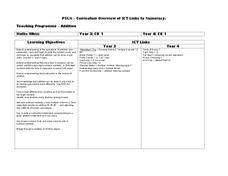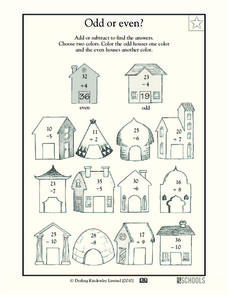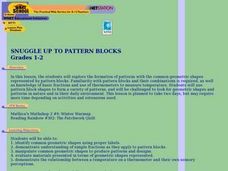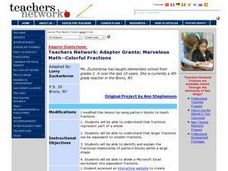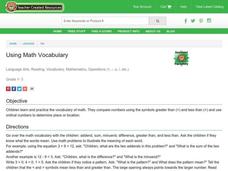Curated OER
My Foot and the Standard Foot
Young mathematicians put one foot in front of the other as they learn how to measure length in an elementary math lesson. Using paper cutouts of their own feet, children measure classroom objects as they discover the importance of...
Illustrative Mathematics
Building toward fluency
Here is a great learning task that focuses on the development of areas in computational fluency including strategies in mental math. Young learners are guided through a list of addition expressions that help them visually understand the...
Curated OER
Addition Word Problems 1, Version 1
In this addition worksheet, students solve word problems containing one and two digit numbers. Students complete 5 addition word problems.
DK Publishing
Multiply or Divide? Part 2
Explore the relationship between multiplication and division as scholars fill in these number sentences, each of which is missing a symbol. Is it a multiplication or division equation? There are 18 of these to start, all written...
Curated OER
Curriculum Links To Numeracy
Youngsters practice looking for the links to numeracy in their classes. This isn't a worksheet but a curriculum guide for an entire unit. Teachers can use any part of the resource to extend or inform their teaching practices related to...
Curated OER
Odd or Even?
There are multiple objectives at play here as scholars solve addition and subtraction problems and determine whether the sums and differences are odd or even. As they solve these, encourage pupils to observe patterns. What happens when...
Curated OER
Multiplying by 10
Multiplying by 10 is simple, but do your scholars know the trick? They look at four examples; if you haven't learned this yet, see if they notice a pattern in these answers. They multiply 70 numbers by 10. Most are two-digit, but a few...
Alabama Learning Exchange
Introduction to Division
Examine how addition, subtraction, multiplication, and division relate to and are separate from each other. As they listen to the book, The Doorbell Rang, they demonstrate the math described in the story by cutting up paper cookies...
Curated OER
What's in the Bag?
Help your students identify the attributes of two-dimensional shapes. They read the book Round is a Mooncake, and use pattern blocks to sort shapes. Students sort shapes according to their attributes.
Utah Education Network (UEN)
Geo Shapes
Invite your first graders to compose and decompose two and three-dimensional figures with this fun, hands-on lesson. They investigate and predict the results of putting together and taking apart two-dimensional shapes with rubber bands...
DK Publishing
Counting Caterpillars
These caterpillars each have a number sequence printed on their segmented bodies, but some numbers are missing! Look at the completed caterpillars as an example, asking kids to notice a possible pattern. They should observe that the...
Curated OER
Con-tents of the Tents
Fill in the missing numbers on this learning exercise. Pupils display the missing consecutive numbers between the tents on the ends of each row. They also match the missing consecutive number for each group of elephants. Students solve...
Dick Blick Art Materials
Painted Story Quilt
Creating story quilts is a great way to combine art, social studies and literature. Kids select a story, a published one or one of their own, to illustrate, paint on a canvas square, embellish, and mount on a felt backing.
Santa Clara County Office of Education
The Rainbow Fish: Activities for Parents to Do with Children at Home
The Rainbow Fish, Marcus Pfister's award-winning story about the joys of sharing, is the inspiration for this resource loaded with fun. Suggestions for language and language arts, math, science, and social studies activities are...
Curated OER
Shape Patterns
In this math worksheet, students examine a pattern of geometric shapes. After looking at the sequence of shapes and deciding what the pattern is, students choose the shape that would come next. There are 4 problems.
Curated OER
Rocket Patterns
Students create their own paper rockets. They identify different patterns and practice making their own. They also discover the concept of sequences.
Curated OER
Snuggle Up To Pattern Blocks
Students view and discuss a video about the use of pattern block shapes to form pictures. They, in groups, form garden and quilt designs using pattern blocks and then decorate the room with their art.
Curated OER
Math Quilts
Students examine geometric shapes. In this geometric shape lesson plan, students examine how geometric shapes flip, turn, and slide to create a pattern. Students analyze the role that quilts played in helping slaves escape to freedom. ...
Curated OER
Marvelous Math -- Colorful Fractions
Students begin the lesson by discovering that a fraction is one part of a whole. In groups, they practice reducting larger fractions into small fractions and discovering they are equal. They use blocks to identify the relationship...
Curated OER
Using Math Vocabulary
Students discover the vocabulary of math. They compare numbers using the symbols greater than (>) and less than (<) and use ordinal numbers to determine place or location. They use worksheets imbedded in this lesson to practice.
Curated OER
Three Little Kittens: Addition Booklet
Students explore math problem solving strategies while reading a nursery rhyme. In this addition instructional activity, students learn math skills such as solving simple equations, graphing data and extending patterns while reading The...
Curated OER
Level 2 Test 2 Math Assessment
For this math assessment worksheet, students complete a 100 question multiple choice test. Included are: mixed operations, fractions, geometry, money, patterns, graphs, time and estimation. Text is written in all capital letters.
Curated OER
Second Grade - Math
In this mixed second grade math review worksheet, 2nd graders answer 25 multiple choice questions. They work with patterns, place value models, fractions, and money in this 8 page worksheet set.
Curated OER
Counting in Three's: Patterns
In this counting by 3 worksheet, students color a square with the number 3 in it, then count by 3's and color each square landed on. Students describe the pattern achieved.




